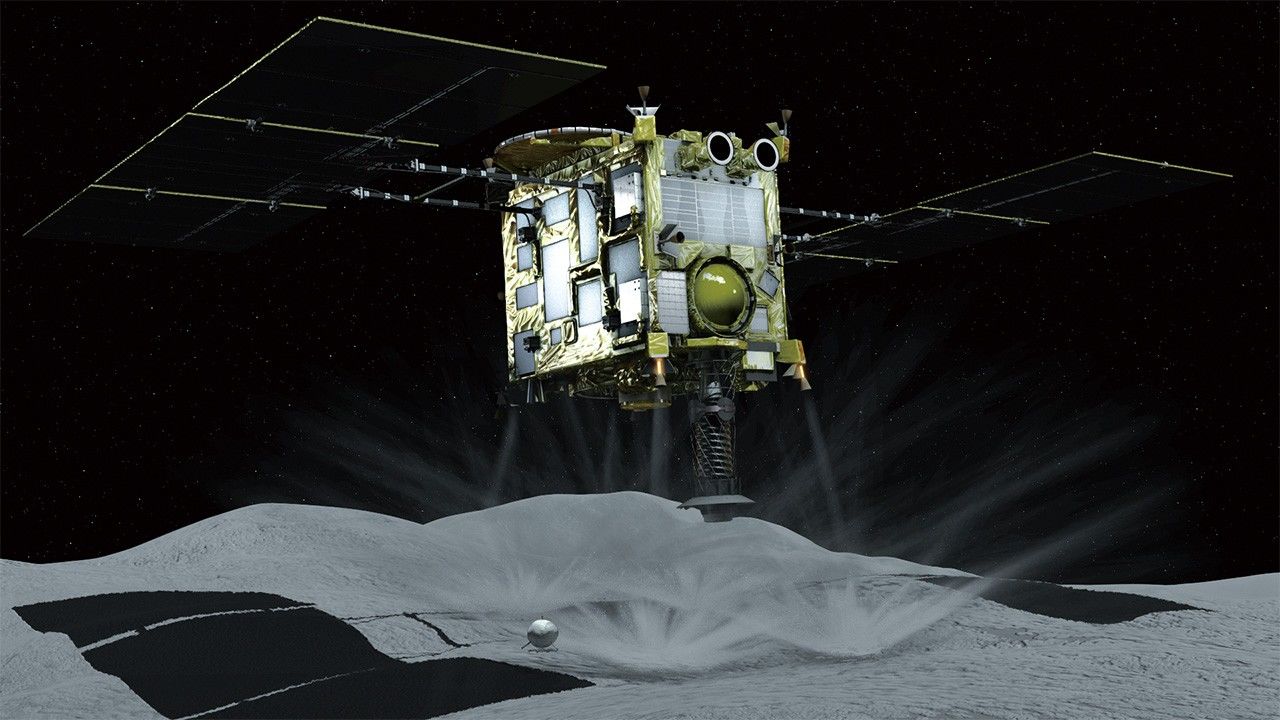
Japan’s Space Program
Science- English
- 日本語
- 简体字
- 繁體字
- Français
- Español
- العربية
- Русский
Fifty years ago, on July 20, 1969, Neil Armstrong became the first human to step outside of planet Earth when US Apollo 11 landed on the moon. That space race was driven by the rivalry between the United States and the Soviet Union, the two Cold War superpowers. Today, in contrast, international cooperation and private-sector support has become indispensable to the enormous funding needed for space exploration.
Japan lagged far behind the Americans and Soviets in launching its first artificial satellite and sending its first astronaut into space, but in recent years the country has become a world leader in the field of asteroid exploration through its Hayabusa and Hayabusa2 spacecraft.
| Year | Event |
|---|---|
| 1955 | Experimental launch of the ultra-compact “Pencil Rocket” developed at the Institute of Industrial Science at the University of Tokyo by a team led by Itokawa Hideo. |
| 1957 | Soviet Union successfully launches Sputnik 1, the world’s first artificial satellite. |
| 1961 | (April) Soviet Union launches Vostok 1 carrying the Soviet cosmonaut Lieutenant Yuri Gagarin—the first person to journey into outer space. (May) The United States successfully launches the manned spacecraft Mercury-Redstone 3. |
| 1962 | Kagoshima Space Center (present-day Uchinoura Space Center) established. |
| 1969 | (July 16) Successful launch of US spacecraft Apollo 11 carrying three astronauts. (July 20) Captain Neil Armstrong becomes the first person to walk on the surface of the moon. |
| 1969 | (October) Establishment of the National Space Development Agency (the predecessor of JAXA) and the opening of the Tanegashima Space Center. |
| 1970 | The University of Tokyo’s Institute of Space and Astronautical Science launches Japan’s first artificial satellite Ohsumi, making Japan the fourth country in the world to succeed in this endeavor (13 years behind the Soviet launch of Sputnik 1). |
| 1975 | National Space Development Agency begins launches of the N-I rocket. |
| 1977 | Japan successfully launches the Kiku-2, its first geostationary satellite. |
| 1981 | Launches begin of the improved N-II rocket, capable of carrying large satellites. |
| 1981 | First launch of the Space Shuttle by the United States. |
| 1986 | Launches begin of the domestically produced two-stage H-I rocket. |
| 1990 | Akiyama Toyohiro, a journalist of the TV station TBS, becomes the first Japanese to take part in a space flight when he travels aboard a Soviet Soyuz spacecraft to the Mir space station, where he stays for six days (roughly 19 years after the first manned flights of the Soviet Union and United States). |
| 1992 | Astronaut Mōri Mamoru takes part in a Space Shuttle flight. |
| 1994 | Launch of the H-II rocket, the first domestically produced rocket to have a first stage, second stage, and an induction-control system. |
| 1994 | The astronaut Mukai Chiaki travels on the Space Shuttle and becomes the first female Asian in space. |
| 1997 | Launches begin of the world’s largest solid-propellant rocket, the M-V. |
| 2001 | Launch of the H-IIA (an improved version of the H-II), achieving a world-class performance compared to both liquid and solid-fuel rockets. |
| 2003 | Launch of the asteroid explorer Hayabusa. |
| 2003 | Formation of the Japan Aerospace Exploration Agency (JAXA) as an independent administration agency through the merger of three organizations: the Institute of Space and Astronautical Science, the National Aerospace Laboratory, and the National Space Development Agency of Japan. |
| 2009 | Operations of Japan’s experiment module Kibō begin on the International Space Station. |
| 2009 | Successful launch of an unmanned cargo transporter (named Kōnotori in 2010) to resupply the International Space Station; all seven cargo ships have safely completed their journey to the station. |
| 2010 | Hayabusa returns successfully to Earth after collecting samples from the asteroid Itokawa. |
| 2014 | Launch of the Hayabusa2 asteroid explorer. |
| 2019 | (February) First landing of Hayabusa2 on the asteroid Ryūgū. (April) An artificial crater for collecting samples is successfully made on the surface of Ryūgū. (July) Hayabusa2 lands for the second time on Ryūgū, and succeeds in gathering asteroid samples. |
| 2020 | Hayabusa2 scheduled to return to Earth around the end of the year. |
Created by Nippon.com based on information from the Cabinet Office, JAXA, and other sources.
(Translated from Japanese. Banner photo: Hayabusa2 touching down on the asteroid Ryūgū. © JAXA.)